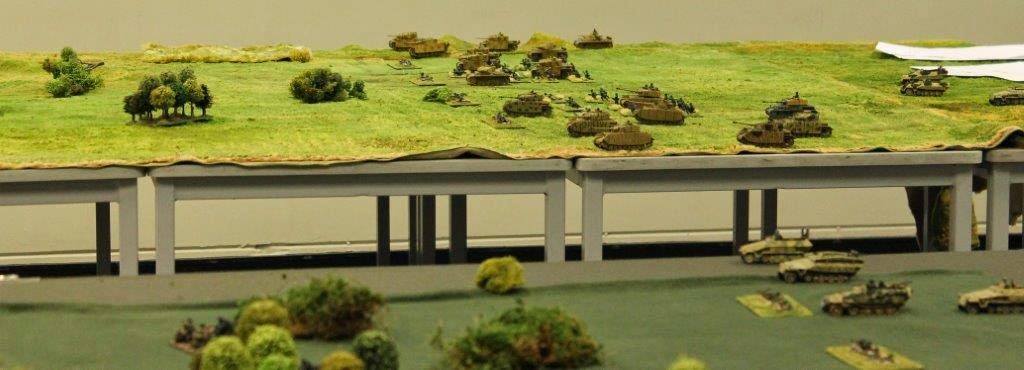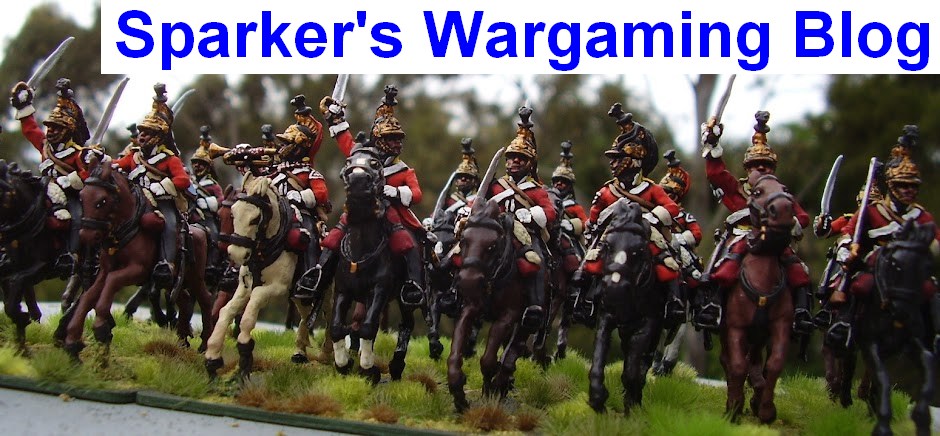
There are
some battles and operations that just defy translation into a wargameable
scenario, not necessarily because of size, everything is scaleable, but because
of the unbalanced odds and the sheer lunacy of the fighting. The actions of 3rd SS Panzer Division ‘Totenkopf’ to take Hill 213.9, as part
of the Mius River actions in the aftermath of the Battle of Kursk is one such
action.
Essentially it is a WW2 armoured version of the ‘Charge of the Light
Brigade’: German Panzers and Panzer Grenadiers charging along a neck of land
overlooked by heights on 3 sides which are lined with heavy Russian guns. The
offensive action undertaken was foolhardy in the extreme, as the failure of
supporting actions to clear the Totenkopf
flanks meant that they were assaulting into a ‘kill sack’ of long range
effective anti-tank crossfire.

Ground. The
area of Southern Ukraine around the Mius river is heavily undulating, with the
terrain furrowed by ridges and carved by numerous watercourses, often dried out
in fierce Russian high summer, but liable to flash flooding - balkas. The land
is fertile and well watered, so that the ground is covered with high vegetation
and crops.
 |
The Red Box in this map was be the table area, representing the high ground between the two balkas stretching from Height 214.9 to 213.9.
|
 |
| The 213-214 ridge was densely vegetated yet overlooked on both sides... |

Situation. As Operation
ZITADELLE, the battle of Kursk was drawing down, with Totenkopf having fought bitterly to establish the Southern pincers
high water mark at the Pena bridgehead,
the Soviets launched their strategic counter stroke, Operation RUMYANTSEV, both
North and South of the Kursk salient.
Particularly threatening was the Soviet 1st
Guards Tank Army’s lodgement across the Mius River to the South of the salient.
In order to push this back, the II SS Panzer Corps was moved South and
reassigned to General der Infanterie Karl-Adolf Hollidt’s reformed 6.Armee in
the Southern Ukraine. The Bridgehead had to be pinched out at all costs before
it was given time to develop into a full scale offensive.
Together Totenkopf, Das Reich and 3rd
Panzer (replacing Liebstandarte, en
route for Italy), conducted a
counterattack from July 30 to August 2 that eventually eliminated the strong
Soviet bridgehead over the Mius River. During these July-August battles for
Hill 213.9 and the town of Stepanowka, Totenkopf
suffered heavy losses, and over the course of the campaign on the Mius it
suffered more casualties than it had during Operation Citadel. By the time the
Soviet bridgehead was eliminated, the division had lost 1500 men dead and the
Panzer regiment was reduced to 20 tanks.
 For this
scenario, we focused on the first Totenkopf effort to drive an all arms Battle
Group across the neck of land linking Height 214.9 to Hill 213.9.
For this
scenario, we focused on the first Totenkopf effort to drive an all arms Battle
Group across the neck of land linking Height 214.9 to Hill 213.9.
The
Totenkopf battlegroup had to advance in the teeth of dug in infantry and anti tank
guns, localised tank counterattacks, and medium and heavy artillery fire
directed from three sides, as well as crossing a heavily mined area.
Mission
Mission - Soviet team (Alan and John T): |
| Photo courtesy of Kaptain Kobold |
Second Guards Mechanised Corps is to destroy assaulting elements of 3rd SS Panzer division Totenkopf.
 |
|
This
scenario and game was always going to be a challenge, but it was specifically
requested by our mate Mark as having always been on his bucket list, and as he
has been unwell I wanted to make it short but memorable – lots of toys on the
table but a quick evening game. This involved several local rules and some
heavy manipulation of the respective battle group ratings.

Both teams;
Mark and John G as the Germans and Alan and John T for the Russians; were given
the opportunity to pre-register artillery targets. Having just lost their field
artillery to an airstrike, the German team seized the opportunity to make best
use of their remaining Mortar platoon. For the Soviets, concentrating their
lavish artillery assets at Corps level, as a scenario specific rule, would have
given them twice the beaten zone with 4 such fireblows, at the sacrifice of
being able to request impromptu missions as normal. This was an attempt to
reflect the burgeoning concentration and sophistication of Russian artillery
tactics detected in the late summer of 1943. However apparently this course
would have stifled Alan’s creativity or somesuch… Fine.
I’m sure Stalin will be
understanding if it all goes pear-shaped…

 Given the
victory conditions, the Germans had a choice between methodically mopping up
the Soviet defences, perhaps paving the way for a follow-on attack (as actually
happened) or going ‘blitzkreig’ hell for leather to capture Hill 213.9 and
ensure that no unpinned Soviet units remained within a metre radius of the spot
height. How quite by chance, my pregame ‘random’ sprinkling of small copses and
small hummocks of ground ended up with the Eastern table looking quite well
covered, and the Western one much more open. Perhaps because of this reason the
German team seemed to decide on a combination of tactics.
Given the
victory conditions, the Germans had a choice between methodically mopping up
the Soviet defences, perhaps paving the way for a follow-on attack (as actually
happened) or going ‘blitzkreig’ hell for leather to capture Hill 213.9 and
ensure that no unpinned Soviet units remained within a metre radius of the spot
height. How quite by chance, my pregame ‘random’ sprinkling of small copses and
small hummocks of ground ended up with the Eastern table looking quite well
covered, and the Western one much more open. Perhaps because of this reason the
German team seemed to decide on a combination of tactics.
I had
insisted that they had to deploy the Tiger company on the left, historically,
and the German team used the 88’s useful HE firepower to methodically start
blowing apart the Soviet trenches. Whilst on the other more open table, the
Panzer IV’s and mounted infantry were pushing hard for the objective.

However with the scenario set for 7 moves, as it was inevitably going to be a slow game with ambitious size forces for relatively inexperienced Battle Group Kursk, and the mutually supporting Russian Infantry, antitank guns, and dug-in T34's proved a challenging task for the Tigers to overcome in close country.
A 57mm Anti Tank gun is on equal terms with a Tiger with a close range shot into its rear, and even the venerable PTRD anti-tank rifle can take out a Sdkfz APC when the infantry is concealed and keep their nerve.

Over on the (unintentionally) more open flank, fast moving PzIVs proved vulnerable to the overwhelming Soviet heavy 203mm and 122mm barrages, so that by the end of move 5 the only German armour close to Hill 213.9 was ablaze! As time was running out we drew stumps.
As well as thanking all who took part, I am especially grateful to John G (pictured left) as the German commander for putting his heart and soul into what was really a pretty hopeless proposition from the outset! The main thing is that Mark (on the right) enjoyed the game and can now cross that one off the bucket list!
Additionally, having calculated seemingly endless Soviet off table artillery missions, I at least am now much more confident in using the Battle Group Kursk artillery rules, which seems to me to be one of this ruleset's big pluses, that and the reactive orders, and the chance to lay suppressive fire.





I was going to ask, whilst I remember, as to how the pre-designated barrages fitted into the order system. Did they cost as many orders as the ad-hoc ones to implement? If not, I can see the point of them, given the amount of our limited activation resources we were spending in a turn keeping the artillery going.
ReplyDeleteAnd you say 'creativity'. I say 'flexibility' :)
Thanks Alan! Yes as the Registered Missions are not called in by an observer, in that sense they are free. But what I was hoping for was the impact of the double beaten zone. Still as it happened you had ample firepower!
DeleteVery cool, id love to involved in a game like that.
ReplyDeleteSteve
Huge and impressive...beautiful tanks and pictures!
ReplyDeleteGreat looking game
ReplyDeleteThanks for your kind comments gentlemen!
ReplyDeleteNice batrep
ReplyDeleteWar is a fascinating subject. Despite the dubious morality of using violence to achieve personal or political aims. It remains that conflict has been used to do just that throughout recorded history.
ReplyDeleteYour article is very well done, a good read.